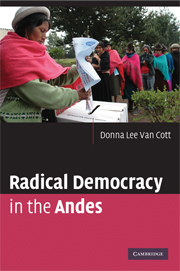Book contents
- Frontmatter
- Contents
- Acknowledgments
- List of Acronyms
- 1 Introduction: The Political and Cultural Origins of Democratic Institutional Innovation
- 2 The Legal and Political Context for Municipal Reform in Bolivia and Ecuador
- 3 Mayoral Leadership and Democratic Institutional Innovation
- 4 Political Parties, Civil Society, and Democratic Institutional Innovation
- 5 Institutional Innovation in Ecuador
- 6 Institutional Innovation in Bolivia
- 7 Conclusion: An Interaction Model of Democratic Institutional Innovation
- References
- Index
6 - Institutional Innovation in Bolivia
Published online by Cambridge University Press: 05 September 2012
- Frontmatter
- Contents
- Acknowledgments
- List of Acronyms
- 1 Introduction: The Political and Cultural Origins of Democratic Institutional Innovation
- 2 The Legal and Political Context for Municipal Reform in Bolivia and Ecuador
- 3 Mayoral Leadership and Democratic Institutional Innovation
- 4 Political Parties, Civil Society, and Democratic Institutional Innovation
- 5 Institutional Innovation in Ecuador
- 6 Institutional Innovation in Bolivia
- 7 Conclusion: An Interaction Model of Democratic Institutional Innovation
- References
- Index
Summary
Owing to the standardization of the LPP throughout Bolivia, there is little variation in the experiences of local government with respect to the design of institutional innovations. All municipalities were required to formulate POAs and five-year municipal development plans using a prescribed participatory planning methodology. All were required to form vigilance committees comprising representatives from civil society organizations. As in Ecuador, indigenous political parties added features derived from indigenous and campesino-union cultures, such as the minga, the fila comunitaria (community line) method for selecting electoral candidates, and accelerated rotation of elected leaders.
Cases diverge with respect to implementation in relation to the political, social, and economic context. This context varied sharply between the departments of La Paz and Cochabamba. As in Ecuador, I chose a small set of geographically clustered cases from two regions where indigenous parties had their greatest electoral success. I show how distinct political conditions in the departments of La Paz and Cochabamba resulted in variations in implementation affecting the democratic quality of local governance. In contrast with Ecuador, where leadership was decisive, what is notable in Bolivia is not the impact of leadership but, rather, its conspicuous absence owing to the overweening influence of local and national movement–party logics and rules, cultural and political norms of accelerated office rotation that prevent mayors from establishing authority, and the top-down imposition of local governance designs that diminished the scope of mayoral initiative. Statistical information with respect to available socioeconomic indicators is presented in Table 6.1.
- Type
- Chapter
- Information
- Radical Democracy in the Andes , pp. 175 - 209Publisher: Cambridge University PressPrint publication year: 2008

